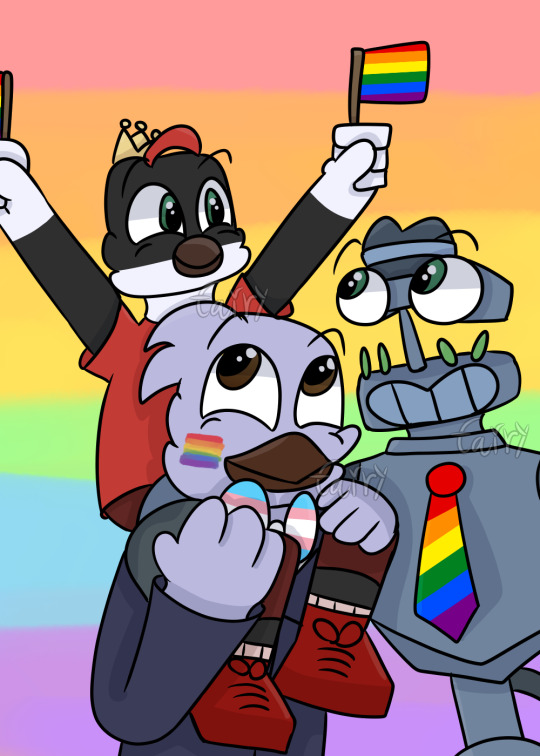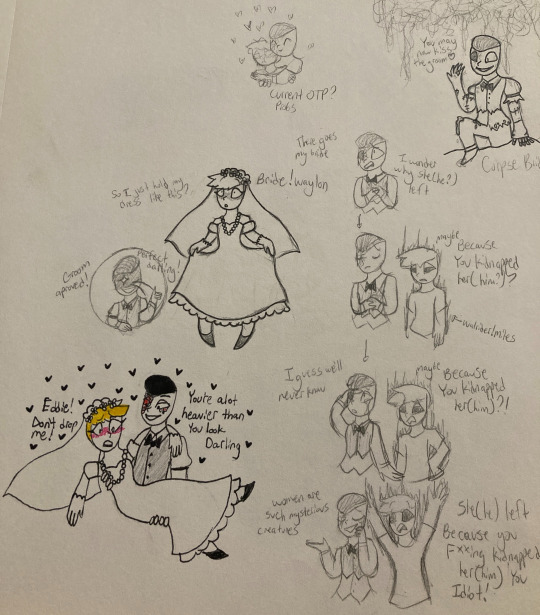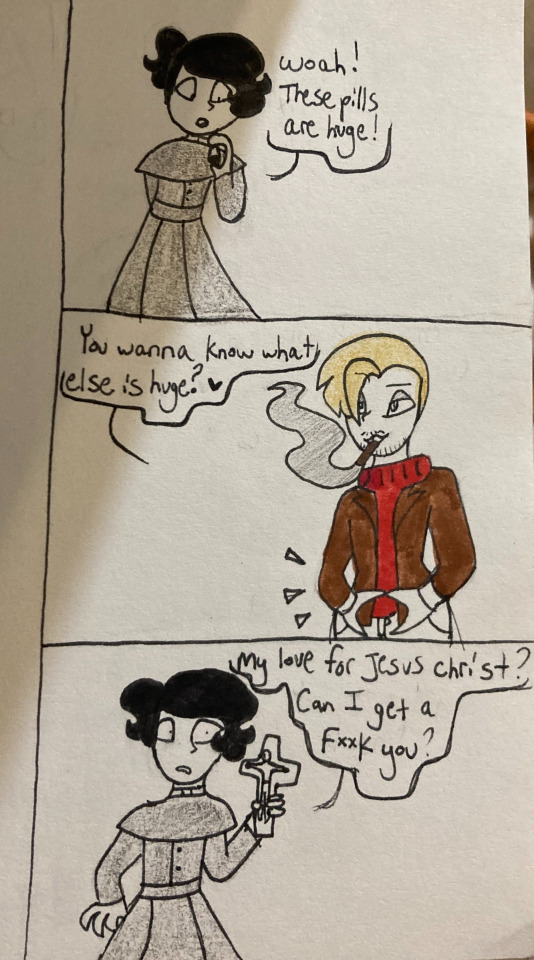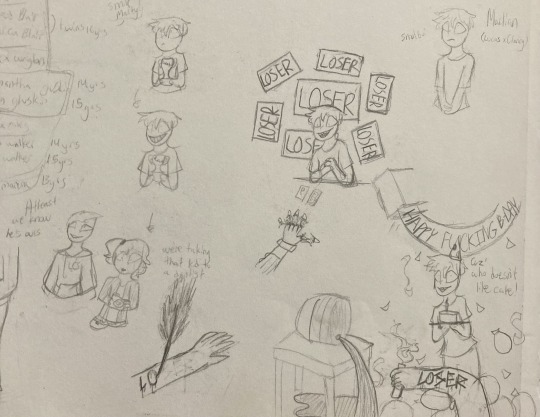#trans clancy
Text
Okay i never posted this here and i need to change that. Wing family goes to pride.

#toontown#toontown corporate clash#ttcc#wing family#Atticus wing#clancy wing#redd heir wing#toontown art#toontown fanart#pride#gay#trans#dani draws#toonblr
29 notes
·
View notes
Text



Clancy and Bea || Ziggy's Characters
More sketches as I try and develop looks for my characters.
#They're both trans men with radically different approaches to their gender expression#portrait#sketches#original art#zig ocs#zig oc clancy#zig oc bea#lgbt art#queer artist#trans art
12 notes
·
View notes
Text
if i happened upon a magical lamp and inside that lamp lived a genie and upon rubbing the lamp the genie came out (congrats to the genie btw) and then said genie offered me three wishes that they would grant with their magical genie powers those wishes would be 1) to look and sound exactly like clancy brown as the kurgan in highlander (1986) 2) a lifetime supply of estrogen and then of course three would be to set the genie free and thank them for their service
#being the kurgan but trans eould fix me actually#the gender envy is real#clancy brown#the kurgan#highlander (1986)#trans
2 notes
·
View notes
Text

me and clancy being transgenders
9 notes
·
View notes
Photo




I WAS LOOKING THROUGH A MIDDLE SCHOOL SKETCHBOOK AND,,,,,WOW THIS REALLY SCREAMS 7TH GRADE
#I GUESS MY OG CLANCY/LUCAS KID WAS A BOY NAMED MARTIAN SO FUCK IT TRANS MARGARET I GUESS#also the old way i drew lucas and clancy. hm. GFDSADFGH#my art
26 notes
·
View notes
Text
New art piece :)
(Sketch under the cut)


7 notes
·
View notes
Text

We wrap up Tom Clancy's End War today! Victory never tasted so sweet.
#queer#lgbtqplus#non-binary#non-binary creator#youtube#queer creator#trans#youtube gaming#youtuber#trans creator#Tom Clancy#End War#Tom Clancy's End War
0 notes
Text
Im currently playing through the halo games because a friend is forcing me at gunpoint.
Having watched the unravelled episode on halo, i am of course already aware that Cortana doesn't jerk Master Chief off through the suit.
But having played about 80% of the first halo game I feel confident in saying she does play with her prostate.
#valk yelling at clouds#The problem with halo so far is the game is too busy trying to be both alien and a tom clancy novel#to realize the game should be about the incredible transgender potential of john-69420#*holding up a sign saying: ask me why the halo guy is a trans woman“
1 note
·
View note
Text
Delara au
Jay is forced to marry Nadakhan instead of Nya, and this time Nadakhan's plan actually works
Jay used his last wish to prevent Nadakhan from marrying Nya
After getting married Nadakhan say "I wish to see my love" which just causes him to see Jay as Delara
Jay is forced to pretend to be Delara, having to hide his whole identity(name and pronouns and everything)
TRANS JAY
Was given the sword containing all of his friends' souls as a wedding gift from Nadakhan
Becomes pirate queen 👑
"I wish you would just forget about those useless Ninja already" - Nadakhan
Lies 24/7 in order to survive
Is good at planning, leading, intimidation, and murder
Scrap'n'tap master
Main weapon is the soul sword(he can electrify it) "the hell are nunchucks"
He is very close to Clancy(plays chess) and dogshank("girl talk")
Powers come in sparks and linked to his emotions, forgot all his formal training
Eventually gets back by traping Nadakhan in the Sword of Souls and wishing to go back to when things were peaceful and he was happy, sending him to pre Skybound but post possession
He has to deal with his new old life now and is struggling
Feel free to leave questions or ideas in the comments!
#ninjago#lego ninjago#ninjago au#Ninjago Delara au#jay ninjago#jay walker#nadakhan ninjago#skybound#Delara ninjago#Sky pirates#VoidMirror posting
59 notes
·
View notes
Text


By: Alex Byrne
Published: Mar 14, 2024
“Computing is not binary” would be a silly slogan—binary computer code underpins almost every aspect of modern life. But other kinds of binaries are decidedly out of fashion, particularly where sex is concerned. “Biology is not binary” declares the title of an essay in the March/April issue of American Scientist, a magazine published by Sigma Xi, the science and engineering honor society. Sigma Xi has a storied history, with numerous Nobel-prize-winning members, including the DNA-unravellers Francis Crick and James Watson, and more recently Jennifer Doudna, for her work on CRISPR/Cas9 genome editing. The essay is well-worth critical examination, not least because it efficiently packs so much confusion into such a short space.
Another reason for examining it is the pedigree of the authors—Kate Clancy, Agustín Fuentes, Caroline VanSickle, and Catherine Clune-Taylor. Clancy is a professor of anthropology at the University of Illinois, Urbana-Champaign; Fuentes is a professor of anthropology at Princeton, and Clune-Taylor is an assistant professor of gender and sexuality studies at that university; VanSickle is an associate professor of anatomy at Des Moines. Clancy’s Ph.D. is from Yale, Fuentes’ is from UC Berkeley, and VanSickles’ is from Michigan. Clune-Taylor is the sole humanist: she has a Ph.D. in philosophy from Alberta, with Judith Butler as her external examiner. In short, the authors are not ill-educated crackpots or dogmatic activists, but top-drawer scholars. Their opinions matter.
Let’s talk about sex, baby
Before wading into the essay’s arguments, let’s look at the context, as noted in the second paragraph. “Last fall,” the authors write, “the American Anthropological Association made headlines after removing a session on sex and gender from its November 2023 annual conference.” The session’s cancellation was covered by the New York Times as well as international newspapers, and it eventually took place under the auspices of Heterodox Academy. (You can watch the entire event here.) Scheduled for the Sunday afternoon “dead zone” of the five-day conference, when many attendees leave for the airport, the title was “Let’s Talk About Sex, Baby: Why biological sex remains a necessary analytic category in anthropology.” The lineup was all-female, and included the anthropologists Kathleen Lowrey and Elizabeth Weiss. According to the session description, “With research foci from hominin evolution to contemporary artificial intelligence, from the anthropology of education to the debates within contemporary feminism about surrogacy, panelists make the case that while not all anthropologists need to talk about sex, baby, some absolutely do.”
Nothing evidently objectionable here, so why was it cancelled? The official letter announcing that the session had been removed from the program, signed by the presidents of the AAA and CASCA (the Canadian Anthropology Society), explained:
The reason the session deserved further scrutiny was that the ideas were advanced in such a way as to cause harm to members represented by the Trans and LGBTQI of the anthropological community as well as the community at large.
Why “the Trans” were double-counted (the T in LGBTQI) was not clear. And although ideas can harm, a handful of academics speaking in the Toronto Convention Centre are unlikely to cause much. In any event, the authors of “Biology is not binary” seem to think that the panelists’ errors about sex warranted the cancellation, not the trauma their words would bring to vulnerable anthropologists. “We were glad,” they say, “to see the American Anthropological Association course-correct given the inaccuracy of the panelists’ arguments.”
Never mind that no-one had heard the panelists’ arguments—what were these “inaccuracies”? The panelists, Clancy and her co-authors report, had claimed that “sex is binary,” and that “male and female represent an inflexible and infallible pair of categories describing all humans.”
“Biology is not binary” is not off to a promising start. Only one of the cancelled panelists, Weiss, has said anything about sex being binary in her talk abstract, and even that was nuanced: “skeletons are binary; people may not be.” No one had claimed that the two sex categories were “inflexible” or “infallible,” which anyway doesn’t make sense. (This is one example of the essay’s frequent unclarity of expression.) Neither had anyone claimed that every single human falls into one sex category or the other.
Probably the real reason the proposed panel caused such a stir was that it was perceived (in Clancy et al.’s own words) as “part of an intentional gender-critical agenda.” And, to be fair, some of the talks were “gender-critical,” for instance Silvia Carrasco’s. (Carrasco’s views have made her a target of activists at her university in Barcelona.) Still, academics can’t credibly cancel a conference session simply because a speaker defends ideas that bother some people, hence the trumped-up charges of harm and scientific error.
Although Clancy et al. misleadingly characterize the content of the cancelled AAA session, their essay might yet get something important right. They argue for four main claims. First, “sex is not binary.” Second, “sex is culturally constructed.” Third, “defining sex is difficult.” And, fourth, there is no one all-purpose definition of sex—it depends “on what organism is being studied and what question is being asked.”
Let’s go through these in order.
“Sex is not binary”
When people say that sex is binary, they sometimes mean that there are exactly two sexes, male and female. Sometimes they mean something else: the male/female division cuts humanity into two non-overlapping groups. That is, every human is either male (and not female), or female (and not male). These two interpretations of “Sex is binary” are different. Perhaps there are exactly two sexes, but there are some humans who are neither male nor female, or who are both sexes simultaneously. In that scenario, sex is binary according to the first interpretation, but not binary according to the second. Which of the two interpretations do Clancy et al. have in mind?
At least the essay is clear on this point. The “Quick Take” box on the first page tells us that the (false) binary thesis is that “male and female [are] the only two possible sex categories.” And in the text the authors say that “plenty of evidence has emerged to reject” the hypothesis that “there are only two sexes.” (Here they mystifyingly add “…and that they are discrete and different.” Obviously if there are two sexes then they are different.)
If there are not exactly two sexes, then the number of sexes is either zero, one, or greater than two. Since Clancy et al. admit that “categories such as ‘male’ and ‘female’…can be useful,” they must go for the third option: there are more than two sexes. But how many? Three? 97? In a striking absence of curiosity, the authors never say.
In any case, what reason do Clancy et al. give for thinking that the number of sexes is at least three? The argument is in this passage:
[D]ifferent [“sex-defining”] traits also do not always line up in a person’s body. For example, a human can be born with XY chromosomes and a vagina, or have ovaries while producing lots of testosterone. These variations, collectively known as intersex, may be less common, but they remain a consistent and expected part of human biology.
So the idea that there are only two sexes…[has] plenty of evidence [against it].
However, this reasoning is fallacious. The premise is that some (“intersex”) people do not have enough of the “sex-defining” traits to be either male or female. The conclusion is that there are more than two sexes. The conclusion only follows if we add an extra premise, that these intersex people are not just neither male nor female, but another sex. And Clancy et al. do nothing to show that intersex people are another sex.
What’s more, it is quite implausible that any of them are another sex. Whatever the sexes are, they are reproductive categories. People with the variations noted by Clancy et al. are either infertile, for example those with Complete Androgen Insensitivity Syndrome (CAIS) (“XY chromosomes and a vagina”), or else fertile in the usual manner, for example many with Congenital Adrenal Hyperplasia (CAH) and XX chromosomes (“ovaries while producing lots of testosterone,” as Clancy et al. imprecisely put it). One study reported normal pregnancy rates among XX CAH individuals. Unsurprisingly, the medical literature classifies these people as female. Unlike those with CAIS and CAH, people who belonged to a genuine “third sex” would make their own special contribution to reproduction.
“Sex is culturally constructed”
“Biology is not binary” fails to establish that there are more than two sexes. Still, the news that sex is “culturally constructed” sounds pretty exciting. How do Clancy et al. argue for that?
There is a prior problem. Nowhere do Clancy et al. say what “Sex is culturally constructed” means. What’s more, the essay thoroughly conflates the issue of the number of sexes with the issue about cultural construction. Whatever “cultural construction” means, presumably culture could “construct” two sexes. (The Buddhas of Bamiyan in Afghanistan were literally constructed, and there were exactly two of them.) Conversely, the discovery of an extra sex would not show that sex was culturally constructed, any more than the discovery of an extra flavor of quark would show that fundamental particles are culturally constructed.
Clancy et al. drop a hint at the start of the section titled “Sex is Culturally Constructed.” “Definitions and signifiers of gender,” they say, “differ across cultures… but sex is often viewed as a static, universal truth.” (If you want to know what they mean by “gender,” you’re out of luck.) That suggests that the cultural construction of sex amounts to the “definitions and signifiers” of sex differing between times and places. This is confirmed by the following passage: “[T]here is another way we can see that sex is culturally constructed: The ways collections of traits are interpreted as sex can and have differed across time and cultures.” What’s more, in an article called “Is sex socially constructed?”, Clune-Taylor says that this (or something close to it) is one sense in which sex is socially constructed (i.e. culturally constructed).
The problem here is that “Sex is culturally constructed” (as Clancy et al. apparently understand “cultural construction”) is almost trivially true, and not denied by anyone. If “X is culturally constructed” means something like “Ideas of X and theories of X change between times and places,” then almost anything which has preoccupied humans will be culturally constructed. Mars, Jupiter and Saturn are culturally constructed: the ancients thought they revolved around the Earth and represented different gods. Dinosaurs are culturally constructed: our ideas of them are constantly changing, and are influenced by politics as well as new scientific discoveries. Likewise, sex is culturally constructed: Aristotle thought that in reproduction male semen produces a new embryo from female menstrual blood, as “a bed comes into being from the carpenter and the wood.” We now have a different theory.
Naturally one must distinguish the claim that dinosaurs are changing (they used to be covered only in scales, now they have feathers) from the claim that our ideas of dinosaurs are changing (we used to think that dinosaurs only have scales, now we think they have feathers). It would be fallacious to move from the premise that dinosaurs are culturally constructed (in Clancy et al.’s sense) to the conclusion that dinosaurs themselves have changed, or that there are no “static, universal truths” about dinosaurs. It would be equally fallacious to move from the premise that sex is culturally constructed to the claim that there are no “static, universal truths” about sex. (One such truth, for example, is that there are two sexes.) Nonetheless, Clancy et al. seem to commit exactly this fallacy, in denying (as they put it) that “sex is…a static, universal truth.”
To pile falsity on top of fallacy, when Clancy et al. give an example of how our ideas about sex have changed, their choice could hardly be more misleading. According to them:
The prevailing theory from classical times into the 19th century was that there is only one sex. According to this model, the only true sex is male, and females are inverted, imperfect distortions of males.
This historical account was famously defended in a 1990 book, Making Sex, by the UC Berkeley historian Thomas Laqueur. What Clancy et al. don’t tell us is that Laqueur’s history has come under heavy criticism; in particular, it is politely eviscerated at length in The One-Sex Body on Trial, by the classicist Helen King. It is apparent from Clune-Taylor’s other work that she knows of King’s book, which makes Clancy et al.’s unqualified assertion of Laqueur’s account even more puzzling.
“Defining sex is difficult”
Aristotle knew there were two sexes without having a satisfactory definition of what it is to be male or female. The question of how to define sex (equivalently, what sex is) should be separated from the question of whether sex is binary. So even if Clancy et al. are wrong about the number of sexes, they might yet be right that sex is difficult to define.
Why do they think it is difficult to define? Here’s their reason:
There are many factors that define sex, including chromosomes, hormones, gonads, genitalia, and gametes (reproductive cells). But with so many variables, and so much variation within each variable, it is difficult to pin down one definition of sex.
Readers of Reality’s Last Stand will be familiar with the fact that chromosomes and hormones (for example) do not define sex. The sex-changing Asian sheepshead wrasse does not change its chromosomes. Interestingly, the sex hormones (androgens and estrogens) are found in plants, although they do not appear to function as hormones. How could the over-educated authors have written that “there are many factors that define sex,” without a single one of them objecting?
That question is particularly salient because the textbook account of sex is in Clancy et al.’s very own bibliography. In the biologist Joan Roughgarden’s Evolution’s Rainbow there’s a section called “Male and Female Defined.” If you crack the book open, you can’t miss it.
Roughgarden writes:
To a biologist, “male” means making small gametes, and “female” means making large gametes. Period! By definition, the smaller of the two gametes is called a sperm, and the larger an egg. Beyond gamete size, biologists don’t recognize any other universal difference between male and female.
“Making” does not mean currently producing, but (something like) has the function to make. Surely one of Clancy et al. must have read Roughgarden’s book! (Again from her other work we know that Clune-Taylor has.) To avoid going round and round this depressing mulberry bush again, let’s leave it here.
“Sex is defined in a lot of ways in science”
Perhaps sex is not a single thing, and there are different definitions for the different kinds of sex. The standard gamete-definition of sex is useful for some purposes; other researchers will find one of the alternative definitions more productive. Clancy et al. might endorse this conciliatory position. They certainly think that a multiplicity of definitions is good scientific practice: “In science, how sex is defined for a particular study is based on what organism is being studied and what question is being asked.”
Leaving aside whether this fits actual practice, as a recommendation it is wrong-headed. Research needs to be readily compared and combined. A review paper on sexual selection might draw on studies of very different species, each asking different questions. If the definition of sex (male and female) changes between studies, then synthesizing the data would be fraught with complications and potential errors, because one study is about males/females-in-sense-1, another is about males/females-in-sense-2, and so on.
Indeed, “Biology is not binary” itself shows that the authors don’t really believe that “male” and “female” are used in science with multiple senses. They freely use “sex,” “male,” and “female” without pausing to disambiguate, or explain just which of the many alleged senses of these words they have in mind. If “sex is defined a lot of ways in science” then the reader should wonder what Clancy et al. are talking about.
In an especially odd passage, they write that the “criteria for defining sex will differ in studies of mushrooms, orangutans, and humans.” That is sort-of-true for mushrooms, which mate using mating types, not sperm and eggs. (Mating types are sometimes called “sexes,” but sometimes not.) However, it’s patently untrue for orangutans and humans, as the biologist Jerry Coyne points out.
Orangutans had featured earlier in the saga of the AAA cancellation, when Clancy and Fuentes had bizarrely suggested that the “three forms of the adult orangutan” present a challenge to the “sex binary,” seemingly forgetting that these three forms comprise females and two kinds of males. Kathleen Lowrey had some fun at their expense.
As if this tissue of confusion isn’t enough, Clancy et al. take one final plunge off the deep end. After mentioning osteoporosis in postmenopausal women, they write:
[P]eople experiencing similar sex-related conditions may not always fit in the same sex category. Consider polycystic ovary syndrome (PCOS), a common metabolic condition affecting about 8 to 13 percent of those with ovaries, which often causes them to produce more androgens than those without this condition. There are increasing numbers of people with PCOS who self-define as intersex, whereas others identify as female.
They seem to believe that two people with PCOS might not “fit in the same sex category.” That is, one person could be female while the other isn’t, with this alchemy accomplished by “self-definition.” PCOS, in case you were wondering, is a condition that only affects females or, in the approved lingo of the Cleveland Clinic, “people assigned female at birth.”
How could four accomplished and qualified professors produce such—not to mince words—unadulterated rubbish?
There are many social incentives these days for denouncing the sex binary, and academics—even those at the finest universities—are no more resistant to their pressure than anyone else. However, unlike those outside the ivory tower, academics have a powerful arsenal of carefully curated sources and learned jargon, as well as credentials and authority. They may deploy their weapons in the service of—as they see it—equity and inclusion for all.
It would be “bad science,” Clancy et al. write at the end, to “ignore and exclude” “individuals who are part of nature.” In this case, though, Clancy et al.’s firepower is directed at established facts, and the collateral damage may well include those people they most want to help.
--
About the Author
Alex Byrne is a Professor of Philosophy at the Massachusetts Institute of Technology (MIT) in the Department of Linguistics and Philosophy. His main interests are philosophy of mind (especially perception), metaphysics (especially color) and epistemology (especially self-knowledge). A few years ago, Byrne started working on philosophical issues relating to sex and gender. His book on these topics, Trouble with Gender: Sex Facts, Gender Fictions, is now available in the US and UK.
==
The whole "social construction," "cultural construction" thing is idiotic.
Not only does it mean you would be a different sex in a different society/culture, but it becomes necessary that cross-cultural/cross-societal reproduction is fraught with complications.
#Alex Byrne#sex pseudoscience#pseudoscience#sex denialism#biological sex#reproduction#biology#human reproduction#queer theory#religion is a mental illness
24 notes
·
View notes
Text
Hello tumblr !
My name is Luke but you may also call me Clancy!! I am a trans man so I would appreciate if you only use he/him pronouns with me!! I am autistic & schizophrenic!! I am in college for 2D animation but I will share my illustrative art here! Also the art I will share in this post is mine! They are of my ocs!!!
I am in a small amount of fandoms!!
This includes:
- Resident Evil
- Outlast (Video Game Series)
- Trolls
- RDR1 & RDR2
- FNAF
- Metalocalypse
************************
- I am open to art trades with mutuals!! I heavily encourage art trades, I love drawing for other people RAHH
- I also have commissions open! My prices are linked on my Kofi !
- My asks and dms are open !!
- I am mainly an OC artist but I will draw fandom stuff from time to time!!
- Proship, Terfs, & NFTs please DO NOT INTERACT
Here is the links to my other socials:






8 notes
·
View notes
Text
Summary:
An unexpected heat catches Dick off-cycle, and he seeks out Slade's scent on the theory that it will help. The arrival of the alpha variant he spent his first, last, and only unmedicated heat with is an added bonus, as are the next few days in Slade's bed.
When Dick's heat passes, the mystery of what triggered it remains, and the answer might not be what he's expecting. And, as it turns out, the last cycle wasn't exactly normal for Slade, either.
Fandom: DCU (Comics)
Rating: Explicit
Archive Warning: Graphic Depictions of Violence
Relationships: Dick Grayson/Slade Wilson, Dick Grayson/Wally West (in flashback)
Characters: Dick Grayson, Slade Wilson,Bruce Wayne, Jason Toddm Roy Harper, Wally West, Garth (DCU), Donna Troy, Bridgette Clancy, William Randolph Wintergreen, Tim Drake, Leslie Thompkins
Additional tags: Alpha/Beta/Omega Dynamics, Non-Traditional Alpha/Beta/Omega Dynamics, Intersex Omegas, Mating Cycles/In Heat, Mating Bond, Oral Sex, Vaginal Sex, Anal Fingering, Breeding Kink, Trans Character, PLEASE READ WARNING NOTES BEFORE THE FIC
Words: 35,419
Series: pack hunters
4 notes
·
View notes
Note
Hi there!!! I wonder if you can suggest me some fcs that works as the parents and siblings for my oc that going to be either jacob elordi or paul mescal? please and thank you so much in advance?? hope both you and mouse have a nice weekend <3 :)
Jacobs' parents and sister ask so here are some siblings:
RJ Mitte (1992) - has cerebral palsy and also a bunch of younger roles!
Jack Mulhern (1994)
Nick Robinson (1995)
Alex Fitzalan (1996)
Elliot Fletcher (1996) - is trans (he/him) and is pro Palestine!
Felix Mallard (1998)
Zoe Terakes (2000) - is non-binary / a trans masc guy (they/he) - is pro Palestine!
And then suggestions for Paul:
Parents:
Imelda Staunton (1956)
Richard E. Grant (1957)
Steve Buscemi (1957)
Fiona Shaw (1958)
Clancy Brown (1959)
Kristin Scott Thomas (1960)
Hugh Grant (1960)
Christopher Meloni (1961)
Elizabeth McGovern (1961)
Terry Farrell (1963)
Christopher Eccleston (1964)
Nicolas Cage (1964)
Elizabeth Hurley (1965)
Kerry Fox (1966)
Daniel Craig (1968)
Michael Sheen (1969)
Peter Dinklage (1969) - has achondroplasia.
Melissa McCarthy (1970)
Siblings:
Laura Berlin (1990)
Barry Keoghan (1992)
Emma D’Arcy (1992) - is non-binary (they/them).
Alex Høgh Andersen (1994) - is pro Palestine!
Thomas Doherty (1995)
Lauren McQueen (1996)
Mary Mouser (1996)
Ruth Codd (1996) - is a below the knee amputee and uses a prosthetic leg.
Asa Butterfield (1997) - is pro Palestine!
Alva Bratt (1998)
Christopher Briney (1998)
Danielle Rose Russell (1999)
Hope this helps!
5 notes
·
View notes
Text


Title: Superman/Batman
Rating: PG-13
Director: Sam Liu
Cast: Kevin Conroy, Tim Daly, Clancy Brown, LeVar Burton, Xander Berkeley, Ricardo Chavira, John C. McGinley, CCH Pounder, Jennifer Hale, Allison Mack, Corey Burton, Calvin Tran, Mark Jonathan Davis, Brian George, Rachael MacFarlane, Alan Oppenheimer
Release year: 2009
Genres: action, adventure, science fiction
Blurb: United States President Lex Luthor uses the oncoming trajectory of a kryptonite meteor to frame Superman and declare a one-billion-dollar bounty on the heads of the Man of Steel and his "partner in crime" Batman. Heroes and villains alike launch a relentless pursuit of Superman and Batman, who must unite and recruit help to try and stave off the onslaught, stop the meteor...and Luthor's plot.
#superman/batman#superman/batman public enemies#superman/batman apocalypse#pg13#sam liu#kevin conroy#tim daly#clancy brown#levar burton#xander berkeley#2009#action#adventure#science fiction
4 notes
·
View notes
Note
Think ab. Think ab Clancy and Mel first getting introduced to each other. The Bishops bring them together and tell them "You're dating now! For the publicity! You don't get a choice in this but you have to act like you did." Mel is like. Soooo skeptical about the situation but then she finds out Clancy is Also Trans and realizes Oh. This is just a little guy. He's so skittish
Clancy is. Afraid of everyone as a baseline I think <///3
I desperately need 2 know what there first couple conversations r like. How do they find out the other is trans?
Also. Mel has been dealing with the horrors 4 longer than clancy I think. And I like the idea of her giving him advice bout like. Dealing with this bullishit yk
13 notes
·
View notes
Text

The battle for Paris rages on as we send countless troops into the heart of the fighting while they get blasted by artillery!
#queer#lgbtqplus#non-binary#non-binary creator#youtube#queer creator#trans#youtube gaming#youtuber#trans creator#Tom Clancy#End War#Tom Clancy's End War
0 notes